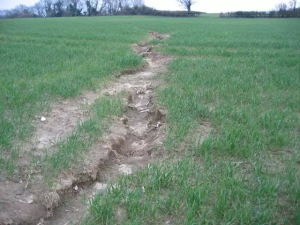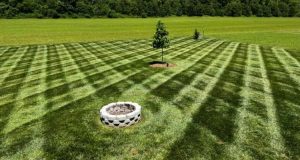Who hasn’t looked at a golf course and thought to themselves, “wouldn’t it be nice if my lawn looked just like that?” A vibrant golf course-style lawn is a dream that many of us have. Just imagine walking out to a well manicured gentle green grass each day. It’d be the perfect place to spend countless hours relaxing on or playing with the kids on. While this style of lawn is definitely magnificent to behold, it can unfortunately be very laborious and expensive to achieve. Now, I am not in any way saying that this is an impossible venture, but it will take dedication and hard work to get your lawn to that pristine look that golfers simply love. In this comprehensive guide, We’ll take you through the process of creating your own golf course-style lawn in 8 steps, ensuring your home becomes the envy of the neighborhood. Let’s dive in!
Step 1: Planning
Before you get ahead of yourself and get your hands dirty, it’s essential to plan your lawn. This will help reduce unexpected challenges from popping up. Consider the size, shape and terrain of your yard, as this will help you figure out how much material you will need. Additionally, the budget is an extremely important factor to consider when planning this sort of project. It is important to create a budget that is realistic and also accomplishes what you are looking to create. Don’t forget to take into account factors such as drainage, irrigation, and accessibility. It’d be a shame to have created a beautiful lawn to only have issues afterwards due to poor drainage or lack of watering. With a little bit of research and the right approach, you can ensure that your hard work and investment pays off in the end.
Step 2: soil preparation
A successful lawn starts with healthy soil. Conduct a soil test to determine its pH level, nutrient content, and texture. The typical lawn you’d find at a golf course requires well-draining soil with a pH between 6.0 and 7.0. Based on the soil test results, amend the soil with organic matter, such as compost, to improve its quality. If necessary, you can also add lime to adjust the pH level. You may also find that you need to smooth or flatten certain areas of your lawn. If you come across this issue, then you’ll want to look at bringing or taking away topsoil from certain areas of your lawn. In more minor cases, then simply bringing sand in to smoothen things out can be all you need.
step 3: Grass Selection
choosing the right grass is crucial for achieving a golf course look. The two main types of grass used in golf courses are Bentgrass and Bermuda grass. Bentgrass is ideal for cooler climates, while Bermuda grass thrives in warmer regions. For transitional climates, you can consider Zoysia grass, which offers a good compromise between the two. That being said, I would give a warning for using those grasses if you live around Ava MO, Houston MO, Willow Spring MO or even West Plains MO. Bentgrass has shallow forming root systems. Ideally you’d want a grass that has strong, deep growing roots so that you can more easily avoid damage to your lawn. Strong roots help a lawn to better tolerate extremes temperatures and drought. For our area of Missouri, we highly recommend that homeowners go with fescue lawns. Fescue will establish deep roots when maintained properly which help them to handle and survive our weather conditions here.
Step 4: Irrigation system
A well-designed irrigation system is essential for maintaining a healthy lawn. Consider installing an automatic sprinkler system that can be programmed to water your lawn at the optimal times. Ensure the system covers the entire lawn evenly, avoiding overwatering or underwatering certain areas.
step 5: Sowing or Laying Turf
Once you’ve decided on the grass type, and you have an irrigation system installed, it’s time to either sow seeds or lay turf rolls (sod). Sowing from seed is more cost-effective but requires more patience, as it takes longer to establish. Laying turf rolls, on the other hand, offers immediate results, but it can be more expensive. Follow the manufacturer’s guidelines for proper spacing, watering, and fertilization.
Step 6: Mowing and Maintenance
Regular mowing is key to achieving that perfectly manicured look. Set your mower at the appropriate height for your chosen grass type, ensuring you don’t cut off more than one-third of the grass blade at a time. Now, most golf courses mow their grass really short. And I mean, really short. We do not recommend this to the general public though. Shorter grass means smaller root systems and more susceptibility to damage and stress. Shorter grass weakens the grass overall which is why golf courses have to tend to and treat their turf more regularly than the average lawn. Shorter grass also allows more weeds to germinate and grow up, causing you to have to spray herbicide on your lawn more often. We always recommend that a lawn should be mowed to an average height of 3.5 inches. The lowest we like to mow is 3.25 inches. Also, keep your lawn mower blades sharp to avoid tearing the grass as well.
In addition to mowing, regular maintenance tasks include fertilizing, aerating, and dethatching. Fertilize your lawn according to the specific needs of your grass type and avoid using excessive amounts, as it can lead to thatch buildup. Aeration helps improve soil compaction and allows nutrients and water to reach the grassroots. Dethatching removes the accumulated layer of dead grass and debris, promoting a healthier lawn. Dethatching is a service that isn’t needed in every part of the US. Around West Plains, Houston MO, or even Ava, for example, we hardly have ever seen a lawn that has needed to be dethatched, but that is something we can discuss in another post for sure.
Step 7: Pest and weed control
Maintaining a pristine golf course-style lawn requires effective pest and weed control. Regularly inspect your lawn for signs of pests or disease and take appropriate action if necessary. Use environmentally friendly pest control methods whenever possible to minimize harm to beneficial insects and the ecosystem.
For weed control, consider using pre-emergent herbicides to prevent weeds from germinating. If weeds do appear, remove them manually or use selective herbicides that target only the unwanted plants while sparing your grass.
Step 8: regular inspections and adjustments
Lastly, ongoing care and attention are essential to keep your golf course-style lawn in top shape. Conduct regular inspections to identify any issues and make necessary adjustments. Be prepared to adapt your maintenance routine based on seasonal changes, weather conditions, and the lawn’s overall health.
Conclusion
In conclusion, creating a golf course-style lawn around your home is labor intensive, and for some people, that is exactly what they want. But for the average homeowner, this is very unrealistic to have your lawn look just like a golf course. This being said, we do offer similar services to our customers so that they can have a lawn that looks as close to a golf course as possible, but while maintaining a healthy and vibrant lawn that can better withstand the natural elements. We strive to help customers have a lawn that is lush, vibrant, and healthy as can be. If you’d be interested in learning more, then please feel free to send us a message or give us a call and we’d be more than happy to begin the process of getting your lawn looking its best!
Who we are and how we can help
Thank you for reading another of our blogs! We are a lawn and landscaping company based in Mountain Grove, Missouri (MO). We have been in business since 2005 and service West Plains, Houston, Ava, Mansfield, Willow Springs, Cabool, and surrounding areas. If you are in need of transforming your lawn and you live in or around these areas, then please reach out to us and we will do our best to help your lawn looks its utmost best. Thank you and have a blessed day!








You actually make it appear so easy with your presentation but I to find this
matter to be really something which I feel I’d by no means understand.
It kind of feels too complex and very huge
for me. I am taking a look ahead for your subsequent post,
I’ll attempt to get the dangle of it! Lista escape roomów